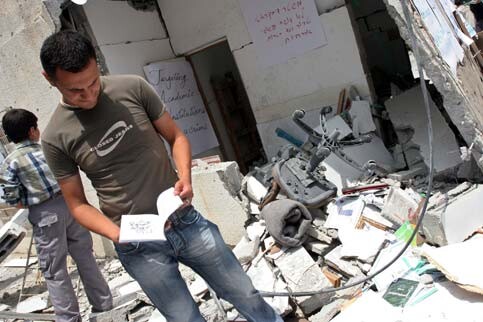The Electronic Intifada 6 July 2006

Palestinians inspects the rubble at the Islamic university in Gaza city July 4, 2006. (MaanImages/Magnus Johansson)
Israel may be preparing to resolve the contentious debate over the expulsion of the Palestinian refugees in 1948 - by repeating it. As Gaza’s civil infrastructure goes into meltdown, worrying parallels are emerging with the chain of events following the withdrawal of the British from Palestine.
The demography of the Middle East has always been the biggest obstacle to the establishment of a Jewish state in Israel. The Zionist project was built upon the dream of a homeland in which Jews would no longer be a minority. Unfortunately, given that the mobilisation of Judaism (and Christian Israelism) towards this goal involved a commitment to the territory of Biblical Israel - a territory already well populated with non-Jews - its logical consequence was the relegation of other populations to the vulnerable status of minority.
The expulsion of Arab populations in order to found a demographically and politically Jewish state has long been an important theme in Zionist thought [1]. However, the extent to which this theme influenced the actions of the founders of Israel, and led to the direct and deliberate expulsion of the Palestinian refugees in 1948, has, of course, long been the subject of controversy. Walid Khalidi’s “Master-Plan” thesis, makes the claim that the expulsion was a conscious and deliberate goal of Ben-Gurion and his Haganah, while Benny Morris’s “transfer principle” argues that the expulsions inevitably emerged from Zionism’s ideological commitment to a Jewish state, and the “facts on the ground” of demographic Arab superiority [1].
Yet there is one aspect of the Palestinian exodus in 1948 that has distinct parallels with the current situation in Gaza - the consequences of the British withdrawal from Palestine. In his attempt to undermine “revisionist” claims of deliberate expulsion policies, Yoav Gelber points out that a key factor in the migration of the Arab populations was the rapid disintegration of Palestinian social and economic structures and public institutions following the end of the British Mandate [2]. In Gelber’s view, the failure of the Palestinians to construct a viable replacement for the British system led to a full-scale collapse of Palestinian society during the pressures of the 1948 Arab-Israeli war and thus to the “voluntary” migration of Arab populations. Of course, given his ideological leanings, Gelber fails to expand on the role of the British and Israelis in encouraging this collapse. However, his central point may prove illuminating for current events.
In September 2005, immediately following Israel’s withdrawal from Gaza, and before the Palestinian Authority could consolidate its new responsibilities, billions of dollars in PA assets were frozen by a US court [3]. The court’s ruling was based on alleged links between PA members, including parliamentarians, and terrorist attacks on Israel. The isolation and criminalisation of the Palestinian Authority therefore began a full four months before the election of Hamas. Within six months of withdrawal, the election of Hamas provided Israel and its allies with the excuse to escalate an ongoing and systematic strangulation of Palestinian institutions and economy via the high profile international “aid freeze” [4].
With 3,457 people per km2, Gaza is one of the most densely populated areas in the world [5] and can sustain itself only through a functioning urban economy and regional trade. Since the beginning of 2006, in a further escalation, the majority of Gaza’s border has been closed to commercial traffic - workers and exports are trapped inside and only trickles of food, fuel and medicine are allowed in. Under this sustained pressure the Palestinian economy is starting to haemorrhage as businesses and capital, always the vanguard of refugee crises, flee the territory [6].
On the eve of the Operation Summer Rains then, despite brave attempts to sustain public administrative structures without pay and raise international funds for supplies, Gaza’s inhabitants were already on the brink of a humanitarian catastrophe. This week’s “surgical” atrocities now make that scenario inevitable. By destroying supply routes and the power station, a massive urban population is being systematically deprived of its life support systems - including water supplies. Combined with Guantanamo-style sleep deprivation - through regular sonic booms - the campaign against Gaza has become the largest experiment in collective psychological torture ever conducted. The clear aim of which is to make life in Gaza intolerable.
Even if Israel eventually submits to UN requests for access for humanitarian aid, it may well be too late. The dying civilian infrastructure will be replaced by a dependency on international aid supplies, to be centrally distributed from a “secure location” away from the clashes between Hamas and the IDF. On July 2, the UN warned that the IDF incursion of Northern Gaza may create 25,000 refugees from Beit Hanoun alone, and that’s just the start [7]. By taking no political action against Israel, and by taking on responsibility for the movement and welfare of refugees within Gaza, the UN may therefore become complicit in the uprooting of Gaza’s population and their transformation from “citizens” into “refugees”. A category of humanity that requires neither a home, nor political identity, or dignity - merely “aid”.
The path to dismantling the Palestinian Authority was cleared by Arafat’s death and has unfolded in incremental steps ever since. Many of Kadima’s critics are seizing on Olmert’s return to Gaza as proof that withdrawal achieved nothing. Indeed, if the PA collapses it will bring the disengagement plan down with it. The logic of Israeli security policy will allow only two choices - reoccupation or expulsion. But for many in Israel, the expulsion of Gaza will not be seen as a failure. Indeed, Olmert’s promises of long-term security and “defining Israel’s borders” will be fulfilled beyond all expectations. It may even be Sharon’s (posthumous?) redemption for the religious right as his disengagement plan is transformed from an unforgivable betrayal of Eretz Israel into the most “righteous” deception in the annals of Zionist ethnic cleansing.
Approaching the intensity of the build up to “al Nakba”, it now seems likely that Gazan society could crumble and fragment under much increased pressure. The crisis that shattered Palestinian society into a million refugees in 1948 was the first Arab-Israeli war. This gave Zionist militias, such as the Haganah, cover for the expulsion of a “hostile and armed populace”. In 1948, the terror, expulsions and massacres of “Plan May” and “Plan Dalet” were carried out under the pretext of rooting out “Arab terrorists” [8]. Similar tactics could easily follow Olmert’s promise of “unparalleled consequences” for the puny and random Qassam rocket attacks against Israeli cities, such as Ashkelon and Ashdod, launched by the Hamas military wing, Izz A-Din Al-Qassam [9]. So, as the IDF and Syrian troops face-off over Israel’s northern border [10], and UN Ambassador John Bolton backs up Olmert’s attempts to escalate the crisis into a regional conflict, the next Arab-Israeli war may well be Gaza’s last stand.
There are no “summer rains” in the arid Eastern Mediterranean. But the phrase does have meaning in the region’s cultural history. Before Egypt built the Aswan Dam the summer rains had a defining influence on Egyptian culture, for it was these rains, on the Ethiopian highlands, which caused the annual flooding of the Nile. In a sick irony evidently amusing to the Israeli leadership, this year’s “summer rains” could cause a very different kind of “flooding” over Egypt’s Eastern border.
Jake Bower is the pseudonym of a postgraduate historian in the UK who specialises in the strategic and tactical framework behind American foreign interventions. The above article was edited from a wider analysis of the regional and global dynamics of the new “great game” for control of energy resources and transit infrastructure.
Footnotes
1. Shavit, Ari. 2004. Survival of the Fittest? An Interview with Benny Morris. CounterPunch. (accessed May 15, 2006).
2. Gelber, Yoav. 2002. Why Did the Palestinians Run Away in 1948?. MidEastTruth. (accessed May 15, 2006).
3. Nielson, Brad. 2005. Palestinian Assets Frozen in the USA. EU Funding. (accessed July 4, 2006).
4. Almberg, Mark. 2006. Western Siege of Palestinians Fuels Misery, Anger. People’s Weekly World. (accessed May 15, 2006).
5. The Daily Star. 2005. Gaza Bursting at Seams without West Bank Link. Palestine Monitor. (accessed May 3, 2006).
6. Myre, Greg. 2006. Giving up Dreams, Gaza Businesses Are Leaving. International Herald Tribune. (accessed July 5, 2006).
7. Baker, Luke. 2006. Israeli assault could displace 25,000 people - UN. Reuters. (accessed July 6, 2006).
8. Miller, Robin C. 2002. The Expulsion of the Palestinians, 1947-1948. Robin C. Miller. (accessed July 6, 2006).
9. Benn, Aluf, and Amos Harel. 2006. Olmert: Qassam Attack on Ashkelon Will Have ‘Unparalleled Consequences’. Haaretz. (accessed July 6, 2006).
10. Katz, Yaakov. 2006. Idf Raises Alert on Syrian Border. Jerusalem Post. (accessed July 5, 2006).
Related Links


